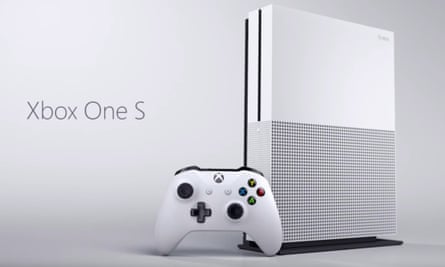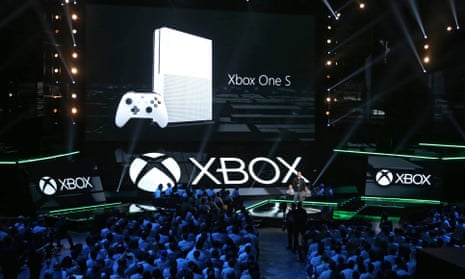Microsoft was surprised and fascinated by Sony’s decision not to support 4K UHD Blu-ray discs with its PlayStation 4 Pro console, an executive has revealed.
Albert Penello, who leads planning for the Xbox division, said that he expected Sony to feature a 4K disc player in its updated PS4 machine, which is launching on 10 November. Microsoft is supporting the format – which allows gamers to player UHD movies on their machine – in both its Xbox One S and Project Scorpio platforms.
“I don’t want to bait any sort of console war, I have a lot of respect for what Sony does, but analytically, I think they made some interesting decisions in their product that surprised me,” he said. “The lack of a 4K disc player, given Sony’s media background, was a surprise. Looking at what they’ve done historically, I don’t think many people would have predicted that.”
“It’s interesting to me that [Sony] arrived at a very similar sort of strategy to Scorpio – we came to this bold idea independently of each other. Even though the tactics are different, the idea, fundamentally, is very similar.”

Penello said he was pleased with the Xbox One S, which was launched last month offering a slimmer build, as well as support for 4K video and HDR visual effects.
“If you step away from the salty internet commentary, we had a group of people working on it for a couple of years, and I’m proud of it,” he said. “When we did the original Xbox 360 Slim, we added a bunch of new features, we improved the quality of the design and I enjoy that process. With Xbox One S, we added a ton of value into the box while keeping the price the same, we really took a leadership position in 4K and HDR, and we made some bold technology decisions with Wi-Fi in the box and going to Bluetooth on the controllers.”
He was also keen to explain the company’s strategy for Project Scorpio, the more powerful Xbox One derivative arriving next winter.
“We made a pretty bold decision in announcing that as early as we did,” he said. “Our reasoning was, when you’re in this new world of iterative consoles, you’re going to want to give customers a little bit more of a heads up – we wanted people to go into this holiday with their eyes open, knowing that Xbox One S was shipping but that Scorpio was coming.
“Frankly it also gave us more time to be open with our development partners so we could get better games when Scoprio launched. There were a lot of rumours about what Sony was going to ship and when, but it didn’t really factor into our decision to announce Scorpio at E3 and it hasn’t really changed our plans. We said we were going to build the most powerful console – that’s going to hold true.”
When asked if there’s a chance consumers may become alienated by a more iterative approach to console development, Penello acknowledged that significantly updating hardware during the lifecycle was a risk.
“This is something we thought a lot about as we were going through the plans for Scorpio,” he said. “Obviously, we have a lot more details to unveil about how that’s going to come to market.
“An analogy with the cellphone market is one way people are reconciling how this change is going to happen. I’ve heard other people make analogies with the PC market; they’re both logical comparisons, but they immediately take you to the pitfalls of those approaches. One of things we have to make sure of is that as we go through this transition with customers and developers in a way that makes sense for the console market.
“We’ve tried to make it very clear: it’s one family of consoles. All of your accessories work, all of your games work. We don’t want customers to feel dumb for buying the wrong thing. We’re going to do it in a way that makes sense for console players. When Scorpio is out and people realise how easy it is, a lot of those fears will be mitigated.”
But a big question is whether consumers actually want 4K resolution technology. UHD television sets are only now becoming affordable and there remains a lot of confusion over the benefits – and over which TV models support which features.
“Naturally technology is going to migrate to 4K,” said Penello. “This is not a flash in the pan – it’s not like 3D TV, it’s not like Smart TVs, I think that 4K is going to be, over the next few years, the predominant screen resolution that people are going to buy when they upgrade their sets. There are groups of data that have varying market share stats, but they pretty much agree that 4K will eventually take over.
“Personally, I think the shift from SD to HD was very meaningful – and I think the same about the move from 1080p to 4K. I do believe that, once the content starts to show up, people will be like, wow, this is worth the upgrade. When you look at a UHD Blu-ray, when you look at a 4K HDR streams from Netflix or Amazon, I believe you can really see the difference.”
There have, however, been doubts expressed in the games media that Project Scorpio would have the processing power to run games that have been rendered in native 4K resolution with HDR effects at 60 frames-per-second. The current Xbox One struggles to render 1080p HD resolution games at that frame rate. Penello confirmed Microsoft’s claims that “true” 4K gaming on Scorpio is the ambition – but stepped away from guaranteeing that this would be achievable at high frame rates.
“On the games, we had to give ourselves a goal for what performance level we wanted to build in the box – and our goal was to be able to deliver true 4K games: the same engines running on Xbox One being about to run in Scoprio on 4K,” he said. “But we’ve said very clearly that it’s up to the developers how they want to take advantage of that power. Some developers focus on effects, some on frame rate some on resolution – it’s up to them what they want to do.”
Penello did state, however, that he has faith that developers will be able to master 4K graphics rendering. “We don’t tell developers what to do,” he said. “But if you go back and look at things like putting a hard drive in a box, cloud computing, and the ethernet port that we included in the original xbox, and now 4K and HDR – these are all things that developers came to us and asked us to support. It’s a dialogue through the product development process – you speak to developers, you look at where technology is going and you make a set of decisions about the platform, the canvas that they create their art on.
“You’ve got to look to PC games development to understand this. In the last five years, there’s been a real renaissance in PC gaming, and that’s happening with Nvidia and AMD investing in really high-end performance – to the point where PCs have eclipsed consoles much more significantly than ever before. In fact consoles used to lead PCs and it would take a while for them to catch up.
“If you look at game engines like Frostbite and Unreal, developers have got really good at scaling – they’re excellent at figuring out how to build textures at very high resolutions, then being able to optimise that artwork for various platforms. With that in consideration, it will be easier to take advantage of the performance difference of Scorpio because these guys are already building games that far surpass what consoles can do today.”
It’s possible, though, that we may have to wait for developers to gain experience with the Scorpio hardware before we seem them pushing the native 4K capabilities of the platform. “The developers have to go through a transition, just like customers,” said Penello. “We are spending as much time and energy on our dev tools as we are on anything customer-facing. Making it easier for developers to take advantage of the power, making it easier for developers who are working on an Xbox One game to get a great Scorpio game and vice versa – we’re developing those tools now.
“It’s a critical part of the work we’re doing to make that transition.”

Comments (…)
Sign in or create your Guardian account to join the discussion